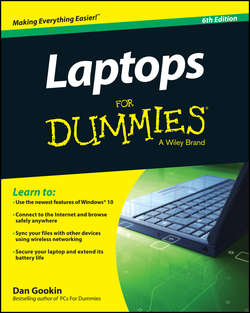Читать книгу Laptops For Dummies - Gookin Dan - Страница 6
На сайте Литреса книга снята с продажи.
Part I
This Laptop Thing
Chapter 1
The Portable Computing Quest
Modern Laptops
ОглавлениеAs technology careened headlong into the 21st century, it became apparent that computer users were desperate for three things from their laptops – in addition to the basic PC compatibility, portability, and communications features that had long ago been deemed must-have items:
✔ Light weight
✔ Long battery life
✔ Full hardware compatibility with desktop systems
Over time, all these qualities were achieved – at a price. Today, the holy grail of a lightweight, PC-compatible laptop that boasts a long battery life isn’t elusive; it’s just expensive!
The notebook
The modern PC laptop is dubbed a notebook. It can sport a full-size keyboard and numeric keypad but often has a compact keyboard. The notebook weighs in anywhere from 2 to 6 pounds, and the battery lasts somewhere between 4 to 6 hours.
The rest of the typical notebook is similar to a desktop PC: LCD screen, wired and wireless networking. Some systems even sport an optical drive (CD and DVD). Putting all these features into a laptop computer gives you today’s notebook.
The subnotebook
Human laps aren’t getting any smaller. Human eyes can comfortably read text that’s only so big. Most important, human fingers have trouble with keyboards that are too tiny. Despite these limitations, a popular notebook category is the subnotebook, which is the smallest, lightest, and most portable type of laptop.
Several kinds of subnotebooks are available, such as the Ultrabook, netbook, and the Ultra Mobile PC (UMPC). Each of these offers compromises on the notebook design, primarily to accommodate for the smaller size and weight. Figure 1-7 illustrates a typical netbook computer.
Figure 1-7: The eensy-weensy netbook PC.
The tablet PC
Computer manufacturers have long attempted to create the electronic equivalent of a pencil and pad of paper – a very expensive pencil and pad of paper. Basically, what they’re after is a portable computer with a monitor but no keyboard. Data is input by using a digital stylus to write directly on the screen.
Over the years, this digital triptych has had various names attached to it: the PenGo computer, the Apple Newton, Pen Windows, and eventually the tablet PC.
The tablet PC can be one of two things. First, it can be a traditional laptop or notebook, but one that features a touchscreen interface. The screen can even bend and twist to cover the keyboard. This type of system might also be called a convertible laptop.
An even lighter and thinner version of the tablet PC exists, such as the Microsoft Surface shown in Figure 1-8. These computers are essentially laptops without a keyboard, although the keyboard is often included as a type of cover.
Figure 1-8: A tablet PC.
Tablet PCs can offer pen input by using a digital pen or stylus. This device effectively brings the laptop quest full circle to a pad of paper and pencil, although fully entrenched in the digital realm.
✔ Don’t confuse the tablet PC with mobile devices, such as the iPad or Samsung Galaxy Tab. A tablet PC differs from these gizmos in that it offers features associated with traditional computers and, thanks to a keyboard, fully substitutes as a laptop computer.
✔ The ancients used something called a tabulae ceratea to write temporary messages. Every Greek or Roman schoolboy took with him to class a folding wooden tablet. Its insides were coated with a black wax. Using a stylus (basically a stick), the student would write into the wax, again and again. Oh, we’ve truly come such a long way.
